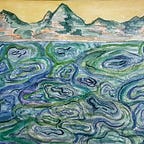DADA as a counterculture
Individual project research (3)
Subculture vs. counterculture:
The term subculture would qualify a population that is part of a ‘dominant’ culture but differ culturally or religiously form it (Dowd and Dowd, 2003). ‘Countercultures are said not merely to be different but to actively reject or deliberately and consciously oppose certain central aspects of the dominant culture.’ (Kendall 1998). What really differentiates the two social terms is the ‘challenging’ attitude of countercultures that are provoking the social norms, while subcultures are ‘conformed’ in society (Dowd and Dowd, 2003).
Art movements are ‘any of many styles of art having an underlying philosophy or goal; many of them have names with an -ism suffix’. As we know, Dada did not want to be categorised or classified by any form of conventional appellation (especially not DADA-ism). Therefore, I would argue that Dada is more of a counterculture than any other art movement.
Anti-art, anti-rock
Dada is fully implicated in expressing their indignations, and so, arguably, Dada would be the first punks. During my research, I found many ideological links to Dada and the punks, notably their strong opposition to war and rejection of any form of social convention.
Both Dada and punks exposed fundamental societal and social questionings, often highly provocative, notably through pamphlets and reviews. Punks shared their political opinions through their music and tracts engaging with subjects such as ‘vivisection, nuclear war, squatting and various organizational and intellectual props of ‘the system’ (Worley, 2015). The punks inspired a whole rebellious generation by denouncing the worst aspects of society. ‘…exploration of the instrumentality of the text to challenge beliefs in immanent signification by implicating the social and institutional settings’ (Worley, 2011).
Dada is imminent; DADA provokes and establishes a direct link between the ‘war mediascape’ and their art practice, by underlining its senselessness (Benson, 2020). Dada is looking to address the meaning of nonsense to the public, all conventional norms are just humanmade artificial concepts.
One of the main common traits of Dada and the punks is their undignified sense of provocation and thirst for conventional and artistic freedom: ‘the formal Dada theory that art could be made out of anything matched the formal punk theory that anyone could make art’ (Marcus, 1989).
